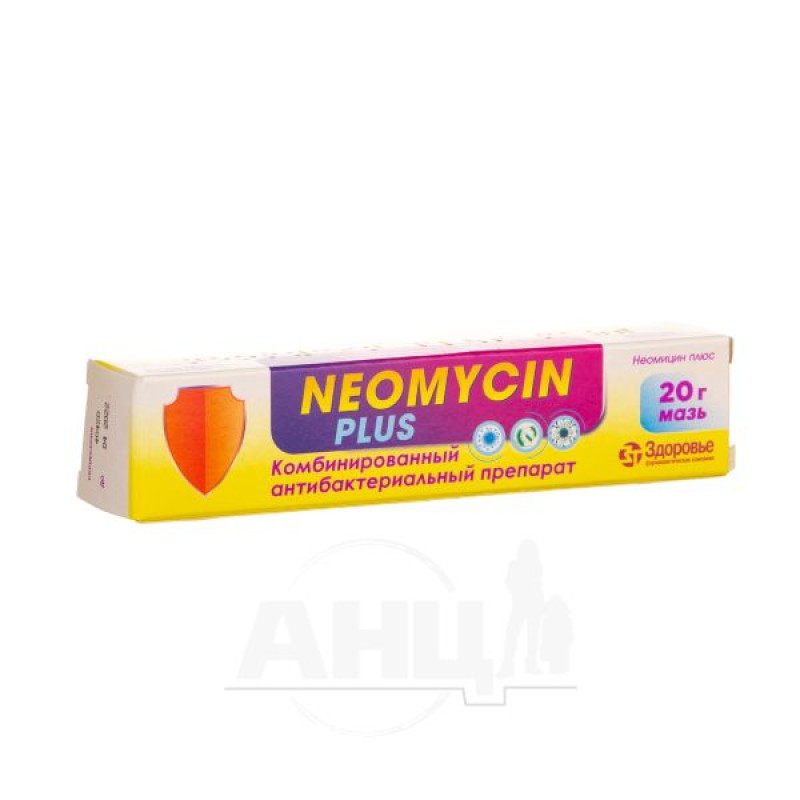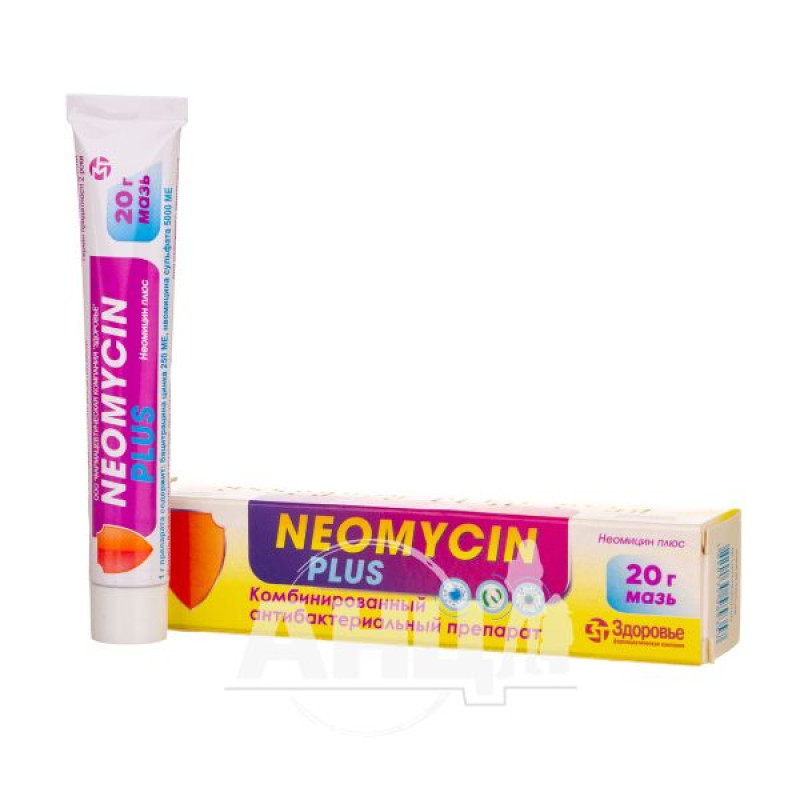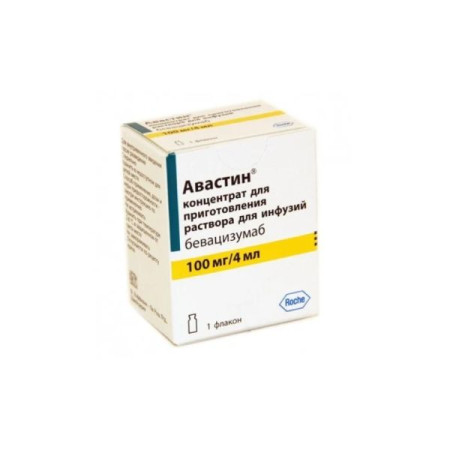Neomycin plus ointment 20 g

Neomycin Plus ointment is used for the local treatment and prevention of bacterial skin infections caused by microorganisms sensitive to the drug:
furuncles, carbuncles (after surgery), abscesses (after autopsy), sycosis, including deep, in the chin area, hidradenitis suppurativa, pseudofurunculosis, paronychia; bacterial skin infections of limited extent, including contagious impetigo, infected varicose ulcers, secondary infections in eczema, infections in burns, after cosmetic surgery and skin transplantation (also for prophylactic purposes and when using dressings); as an adjunct therapy in the treatment of infected wounds (for example, in otitis externa, secondary infection of surgical scars).Composition
1 g of the drug contains (active ingredients):
bacitracin zinc - 250 IU; neomycin sulfate - 5000 IU.Excipients: lanolin, mineral oil, white soft paraffin.
Contraindication
Hypersensitivity to the components of the drug or to other aminoglycoside antibiotics. Significant and severe skin lesions (resorption of the drug with the development of an ototoxic effect with hearing loss is possible). If uncontrolled absorption of the drug is possible, it should not be used in patients with severe cardiogenic or nephrogenic excretory disorders, as well as in the presence of a history of lesions of the vestibular and cochlear systems. Do not use in the external auditory canal with perforation of the eardrum. Do not use on the area around the eyes.Method of application
Adults and children should usually apply Neomycin Plus ointment 2-3 times a day for 7 days.
When used topically for more than 7 days, the dose of neomycin should not exceed 1 g per day (equivalent to 200 g of ointment). When repeated courses are used, the maximum dose should be halved.
Apply a small amount of ointment to the affected area and rub in lightly. If necessary, a gauze bandage can be applied to the affected area after applying the drug.
Application features
Pregnant women
If there is a risk of absorption of active substances during pregnancy and breastfeeding, the ointment can be used only if, in the opinion of the doctor, the expected benefit to the mother outweighs the potential risk to the fetus or child. Like other aminoglycoside antibiotics, neomycin penetrates the placental barrier. There have been reports of hearing impairment in the fetus due to systemic use of high doses of aminoglycosides.
Before breastfeeding, it is necessary to remove the remnants of the drug from the mammary gland with boiled water and sterile cotton wool.
Children
There is insufficient data on the safety of using the drug in this dosage form in young children, therefore the use of the drug in children is possible only on the prescription of a doctor after a careful assessment of the benefit/risk ratio.
Overdose
When using doses significantly exceeding the recommended ones, due to the possible absorption of active substances, symptoms indicating nephro- and/or ototoxic reactions should be taken into account, especially in patients with trophic ulcers.
Treatment: therapy is symptomatic.
Side effects
The frequency of adverse reactions is defined as follows: rare (≥ 1/10,000, <1/1,000), very rare (<1/10,000), frequency unknown (cannot be estimated from the available data).
Usually, the drug is well tolerated when used externally.
On the part of the immune system: rarely - in the presence of allergic reactions to neomycin, cross-allergy to other aminoglycoside antibiotics also occurs in approximately 50% of cases; frequency unknown - hypersensitivity to neomycin and many other substances may occur when the drug is used for chronic dermatoses or chronic otitis media. Under certain circumstances, allergy may manifest as the absence of successful wound healing.
From the nervous system: unknown - vestibular nerve damage, neuromuscular blockade.
From the side of the organs of hearing and labyrinth: frequency unknown - ototoxicity.
Skin and subcutaneous tissue disorders: rarely - allergic reactions, mainly manifested as contact dermatitis. Allergic reactions caused by neomycin do not occur as often as generally believed; frequency unknown - in case of prolonged use, allergic reactions such as redness, dryness and peeling of the skin, rash, itching may occur. Spreading of lesions or lack of healing may be caused by allergies. Photosensitization or phototoxic reactions when exposed to sunlight or ultraviolet radiation cannot be ruled out.
On the part of the kidneys and urinary tract: frequency unknown - nephrotoxicity.
Storage conditions
Store in the original packaging at a temperature not exceeding 25 °C, out of the reach of children.
Shelf life - 2 years.
There are no reviews for this product.
There are no reviews for this product, be the first to leave your review.
No questions about this product, be the first and ask your question.









